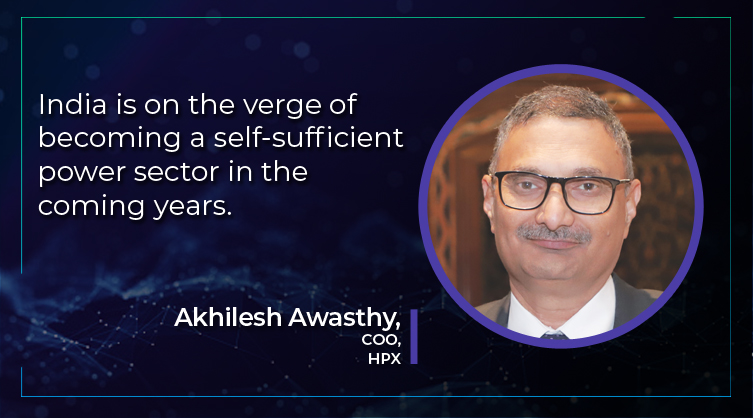India will become a reliable energy exporter soon
By Admin February 3, 2023 11:49 am
By Admin February 3, 2023 11:49 am

Apart from focusing on establishing a self-sufficient power sector to increase energy exports, Akhilesh Awasthy, COO of Hindustan Power Exchange, says that the view for 2023 includes a focus on green hydrogen and the creation of a separate market for carbon trading.
How do you rate the performance of the power sector in 2022?
2022 may be seen as a favourable year for the Indian power market. The government did introduce various regulatory and policy measures to drive the sector effectively. We saw the government initiating various policies to promote green power, strongly emphasising storage and green hydrogen. The government created the Late Payment Surcharge Rules, 2022 to ensure timely payments by the DISCOMs to the generators.
At the same time, the year was filled with quite a few challenges, particularly the power crisis in April–May 22 caused by fuel supply constraints. The effects were seen visibly over power exchange transactions, where the market clearing prices touched ₹20/kWh ceiling. The honourable commission had capped the day’s market prices at ₹12/kWh. Later, the prices in the term-ahead segment were also capped at Rs 12 per kWh.
India also increased its installed renewable energy capacity by 14.21 GW through October, moving it to fourth place globally. The government announced the second round of the Productivity-Linked Incentive (PLI) scheme, worth ₹19,500 crores, for the production of high-efficiency solar photovoltaic (PV) modules. Additionally, new renewable purchase obligation (RPO) targets were announced, with wind energy receiving a special category to help the sector grow. The outlook for 2023 further focuses on green hydrogen, and a separate market for carbon trading is envisaged. In this regard, the trading in ESCerts of power exchanges has resumed, and the trade is set to take place shortly.
What are the ongoing trends in India’s power trading and exchange business?
The power sector is expected to undergo a major transformation concerning demand growth, energy mix, and market operations. The term-ahead segment of the power exchange platform saw the introduction of several new contracts over the last year. The market saw the introduction of long-duration contracts with the extension of daily and weekly contracts beyond 11 days to a maximum of 90 days. The market also saw the introduction of monthly contracts and one-day single-sided contracts (based on E-Reverse Auctions) over the exchange platform.
Another major development on the power trading platform is the resumption of ESCert trading. With the talks for a carbon market intensifying and BEE proposing the carbon trading mechanism through its draught papers, we can thus see the trade of ESCerts and carbon becoming more profound in the coming months.
What are the major challenges confronting India’s power sector?
With India aiming to meet a large portion of its electricity needs through renewables, there will be a growing concern about integrating renewable energy into the grid. Sources are highly variable; it is paramount to have an adequate system to meet the sudden rise or fall in demand across the country. In other words, India would need a capacity market to meet the sudden rise or fall in demand. The honourable commission provided the draught guidelines for resource adequacy in 2022, and more developments are expected.
At the same time, high aggregate technical losses and distribution utilities’ poor financial health will always be challenging. Recently, the government introduced the Revamped Distribution Sector Scheme (RDSS) to provide financial support to distribution utilities to enhance the dependability and quality of power supply to end users.
We use cookies to personalize your experience. By continuing to visit this website you agree to our Terms & Conditions, Privacy Policy and Cookie Policy.